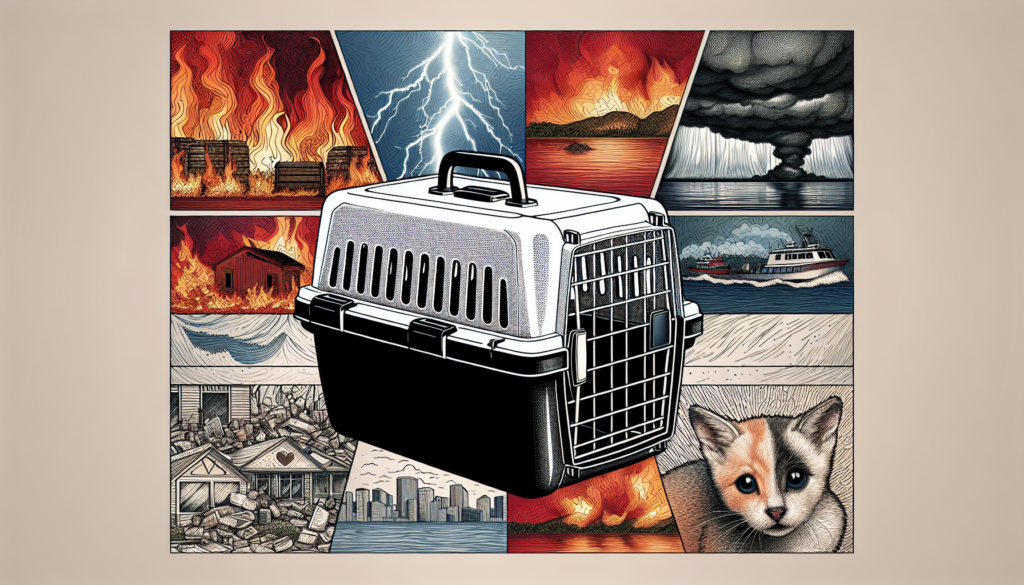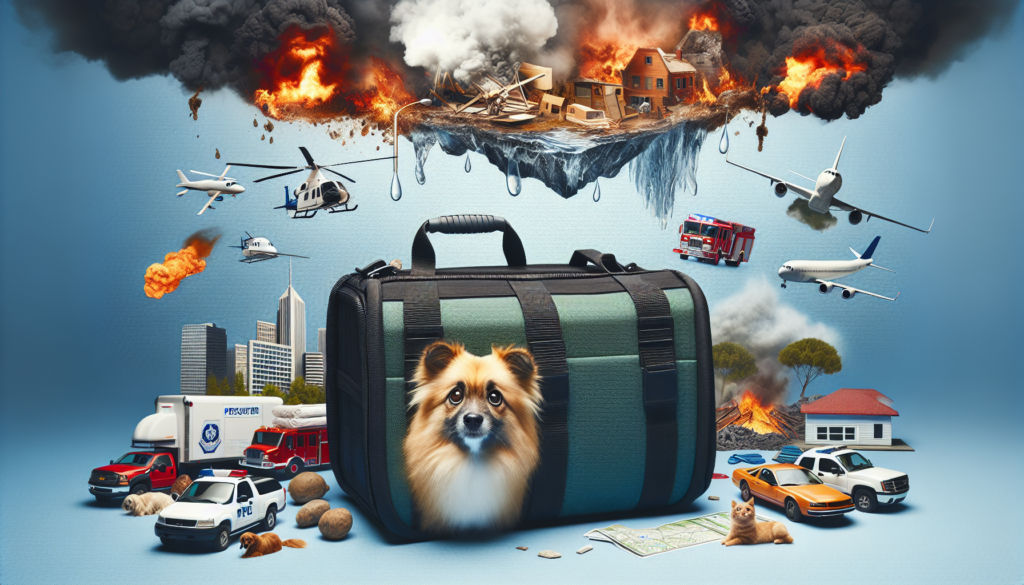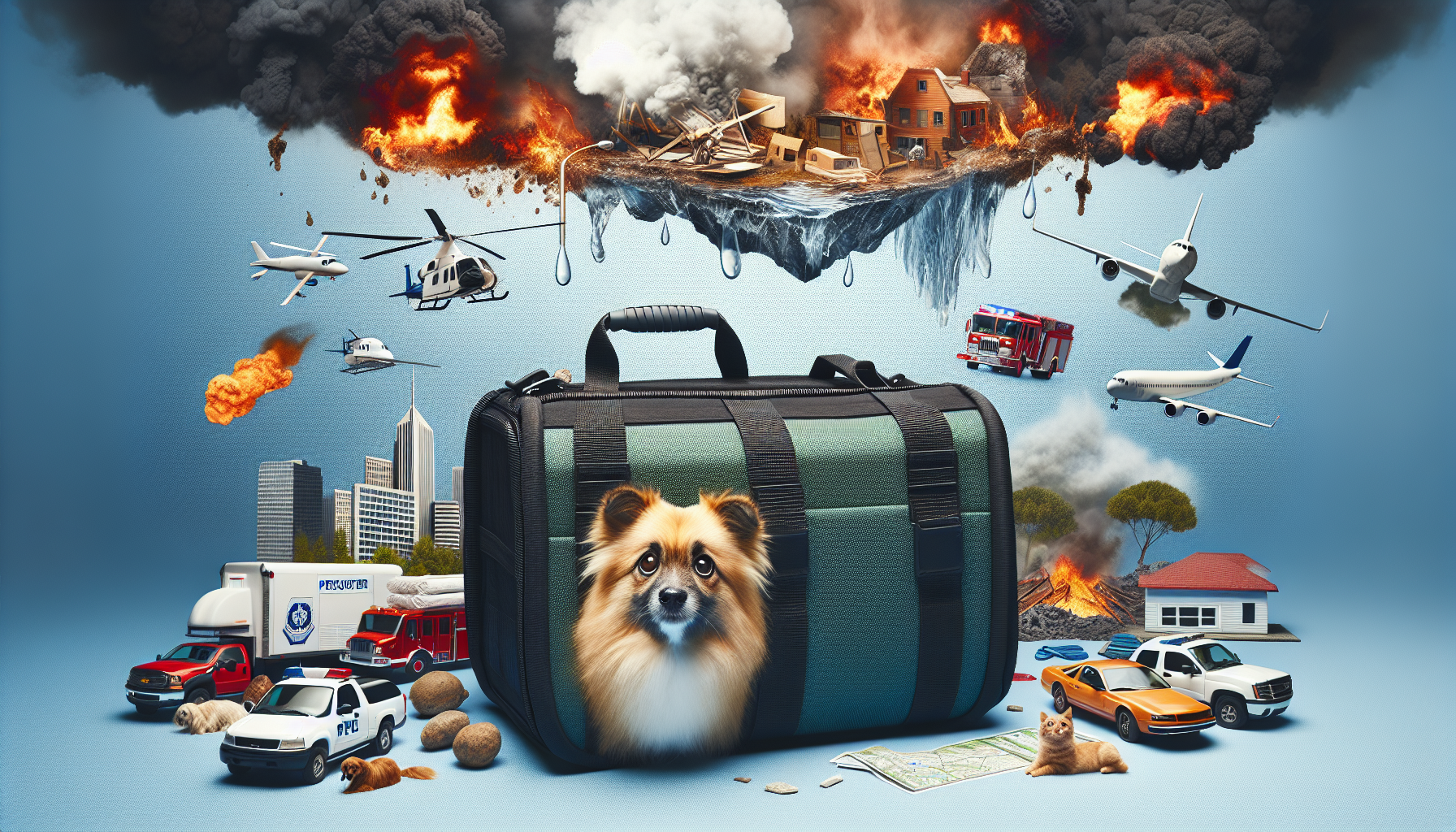In this article, you will discover essential tips and strategies on how to create a disaster preparedness plan specifically tailored for your beloved pets. We all want to keep our furry friends safe and sound during unforeseen events, such as natural disasters or emergencies. By following these guidelines, you will be equipped with the necessary knowledge and tools to ensure the well-being of your pets in times of crisis. So, let’s dive in and explore how you can protect and care for your furry companions when disaster strikes.

1. Assessing Potential Disasters
When it comes to disaster preparedness for your pets, the first step is to assess the potential disasters in your area. By understanding the specific risks you and your pets may face, you can be better prepared to protect them in case of an emergency.
1.1 Identifying common disasters in your area
Start by identifying the common disasters that occur in your area. Is your region prone to hurricanes, wildfires, earthquakes, or floods? By knowing the most likely disasters, you can tailor your pet preparedness plan to address those specific risks.
1.2 Understanding the risks
Once you have identified the common disasters, take the time to understand the risks associated with each one. How can these disasters impact your pets? For example, during a flood, your pets may be at risk of drowning or being separated from you. By comprehending the risks, you can prioritize the necessary preparations.
1.3 Researching historical incidents
To gain further insight into the potential dangers, research historical incidents that have occurred in your area. Examine how pets were affected in those situations and learn from the experiences of others. Their stories can provide valuable lessons on what to do and what to avoid during emergencies.
1.4 Consulting with local authorities
Lastly, consult with local authorities, such as emergency management offices or animal control agencies, to gather additional information about the potential disasters in your area. They can provide specific guidance on how to prepare and protect your pets in different scenarios. Building a relationship with these authorities can also help you receive timely updates and alerts during emergencies.
2. Preparing Emergency Kits for Pets
Having a well-stocked emergency kit for your pets is crucial for their safety and well-being during disasters. Here are some essential steps to help you gather the necessary supplies.
2.1 Gathering essential supplies
Assemble a kit that includes at least a three-day supply of food and water for each pet, as well as food and water bowls. Include any necessary medications, along with a pet first aid kit, which should contain items such as bandages, antiseptic solution, and any specific medications or treatments your pets may need.
2.2 Including important documents
Make sure to include important documents in your pet’s emergency kit. This includes vaccination records, identification papers, and any licenses required by your local authorities. Having these documents readily available can help prove ownership and expedite reuniting you with your pets if you are separated during a disaster.
2.3 Considering special needs of your pets
Consider any special needs your pets may have and pack accordingly. If your pet requires specific medications or medical equipment, ensure you have an adequate supply in your emergency kit. Also, take into account any comfort items your pets may need, such as blankets or toys, to help reduce anxiety during stressful situations.
2.4 Ensuring food and water
When packing food for your pets, choose items with a long shelf life, such as dry kibble or canned food. Rotate these items periodically to ensure they remain fresh. Remember to pack a manual can opener if needed for canned food. Don’t forget to include a collapsible water dish and bottles of water to keep your pets hydrated.
2.5 Providing comfort and familiar items
In addition to essential supplies, consider including familiar items that bring your pets comfort. This can be their favorite blanket, toys, or even an unwashed article of clothing that carries your scent. Having these items in their emergency kit can help reduce stress and provide a sense of familiarity during challenging times.
3. Developing a Pet Evacuation Plan
A pet evacuation plan is vital for ensuring the safety of your pets when you need to leave your home during a disaster. Consider the following steps when developing your plan.
3.1 Identifying safe evacuation routes
Research and identify safe evacuation routes in your area. Familiarize yourself with the roads and potential obstacles, such as bridges or low-lying areas prone to flooding. It is essential to know multiple routes to ensure you can adapt if circumstances change.
3.2 Choosing temporary shelter options
Research potential temporary shelter options for your pets, such as pet-friendly hotels or boarding facilities. Keep a list of these places along with their contact information in your emergency kit. Many emergency shelters may not accept pets, so it’s important to have alternatives ready.
3.3 Making arrangements with friends or family
If you have friends or family members living outside the affected area, consider making arrangements with them to provide temporary shelter for your pets. Make sure they are willing and able to accommodate your pets and discuss the details in advance, such as the number of pets and any specific requirements or preferences.
3.4 Researching pet-friendly hotels or shelters
In case you are unable to secure temporary shelter with friends or family, research pet-friendly hotels or shelters in areas further away from the disaster zone. Many hotels and shelters have specific policies and restrictions for pets, so it’s crucial to be aware of their guidelines and reservations procedures in advance.
3.5 Preparing necessary transportation
When developing your pet evacuation plan, consider how you will transport your pets to safety. Depending on the size of your pets, you may need carriers, crates, or harnesses. Ensure your pets are comfortable with these transportation options and practice using them before an emergency occurs.
4. Ensuring Proper Identification and Documentation
Proper identification and documentation are vital during emergencies to ensure the safe return of your pets. Take these steps to ensure their identification is up to date.
4.1 Microchipping your pets
Microchipping your pets is an effective way to ensure they can be identified and reunited with you if they become lost during a disaster. Ensure the microchip information is registered and kept up to date with your current contact details. This increases the chances of being contacted if your pet is found.
4.2 Updating ID tags and collars
Regularly update your pets’ ID tags and collars with your current contact information. These visible forms of identification can help bring your pets home if they are found by someone in your community. It is recommended to include both a phone number and an email address for increased reachability.
4.3 Keeping important documents handy
Keep copies of important documents, such as vaccination records, identification papers, and licenses, in a waterproof container within your emergency kit. Additionally, store digital copies of these documents on a secure cloud-based platform. This way, you can access them from any location with an internet connection, even if the physical copies are lost or damaged.
4.4 Preparing current photographs
Include current photographs of your pets in your emergency kit. These photos can serve as valuable tools for identification and can be shared with local authorities, shelters, or search-and-rescue organizations. Include clear images that show unique markings or features that could aid in identifying your pets.

5. Communicating with Pet Care Providers
Effective communication with your pet care providers ensures that your pets receive necessary support during an emergency. Take these steps to stay connected.
5.1 Notifying your veterinarian
Inform your veterinarian about your disaster preparedness plan and provide them with updated contact information. Inquire about their emergency procedures and whether they offer any special assistance or advice during disasters. By maintaining a good relationship with your veterinarian, you can access valuable guidance and support if needed.
5.2 Arranging alternative pet care
In the event that you are unable to care for your pets during a disaster, make arrangements with a trusted friend, family member, or professional pet sitter who can step in and provide temporary care. Ensure they are aware of your pet’s needs, the location of their emergency kit, and have contact information for your veterinarian.
5.3 Exchanging contact information with pet sitters or boarding facilities
Exchange contact information with your pet sitters or boarding facilities in advance. Provide them with your emergency contact information and keep their details on hand, including their address and phone number. This will facilitate communication and ensure that you can be easily reached in case of an emergency or temporary separation.
6. Creating a Pet Emergency Contact List
Having an up-to-date pet emergency contact list is essential for staying organized and connected during emergencies. Consider these steps when creating your list.
6.1 Listing emergency contacts
Create a comprehensive list of emergency contacts, including your family members, friends, neighbors, and anyone else who can assist in the care and well-being of your pets during a disaster. Include their names, phone numbers, addresses, and any other relevant details. Keep this list in your emergency kit and ensure it is easily accessible.
6.2 Including veterinary information
Include your veterinarian’s contact information in your pet emergency contact list. This allows you to quickly reach out for advice or assistance in case of an emergency. Include the clinic’s name, phone number, address, and any after-hours emergency contact information if applicable.
6.3 Adding local animal control or rescue centers
Research and include contact information for local animal control or rescue centers in your pet emergency contact list. These organizations can provide guidance or assistance during emergencies, such as locating lost pets or providing temporary shelter. Ensure you have their phone numbers, addresses, and any specific instructions they may have during disasters.
7. Training Your Pets for Emergency Situations
Training your pets for emergency situations can help them stay safe and calm during a crisis. Consider the following steps when preparing your pets.
7.1 Familiarizing them with carriers or crates
Introduce your pets to their carriers or crates well in advance of any emergency situation. Make it a positive experience by offering rewards, treats, or toys while they are inside. Gradually increase the duration of time they spend in the carrier, ensuring they are comfortable and relaxed.
7.2 Practicing obedience commands and recall
Regularly practice obedience commands with your pets, such as sit, stay, and come. In emergency situations, having reliable obedience skills can help keep your pets safe and prevent them from becoming lost or injured. Use positive reinforcement techniques and provide treats or praise for a job well done.
7.3 Introducing them to unfamiliar environments
Expose your pets to unfamiliar environments to help them become more adaptable and confident. Take them on car rides, visit new places, or introduce them to friends or family members’ homes. This way, they will be better prepared to handle the stress and novelty of new surroundings during an evacuation.
7.4 Socializing them with other animals
Socialize your pets with other animals to help them feel at ease in different situations. Arrange playdates with well-behaved and vaccinated pets, or consider enrolling them in obedience classes or socialization programs. By exposing them to various animals, they will be more comfortable and less likely to exhibit anxious or aggressive behavior during emergencies.
8. Staying Informed During Disasters
Staying informed during disasters is crucial to make timely decisions and ensure the safety of your pets. Follow these steps to stay up to date.
8.1 Monitoring local weather updates
Stay informed about local weather updates, as they can help you anticipate potential disasters and take necessary precautions. Use reliable sources such as the National Weather Service or local news channels to receive accurate and timely information. Be aware of any alerts or warnings issued for your area.
8.2 Following emergency alerts
Sign up for emergency alert systems provided by local authorities or disaster management organizations. These alerts will notify you directly about potential disasters, evacuation orders, or any other critical information related to your safety and the safety of your pets. Ensure the contact information you provide is accurate and regularly updated.
8.3 Checking official disaster communication channels
Frequently check official disaster communication channels, such as social media accounts or websites of local authorities and emergency management offices. They often provide real-time updates, evacuation routes, and safety guidelines specific to your area. Stay connected and aware of the latest information to make informed decisions.
8.4 Having a battery-powered radio
Invest in a battery-powered or hand-cranked radio and keep it in your emergency kit. This will allow you to access important news and updates even if the power goes out or other communication channels are unavailable. Make sure to have extra batteries or a hand-crank charger to ensure the radio remains operational during extended power outages.
9. Reviewing and Updating the Plan
Regularly reviewing and updating your disaster preparedness plan ensures its effectiveness and relevance. Consider these steps when conducting plan evaluations.
9.1 Conducting regular plan evaluations
Set a recurring schedule to conduct plan evaluations at least once a year or whenever there are significant changes in your life or the environment. Evaluate each aspect of your pet disaster plan and make any necessary adjustments to address new challenges or circumstances.
9.2 Modifying the plan as needed
Modify your pet disaster plan based on the findings of your evaluations. Update any contact information, addresses, or emergency supplies in your emergency kit. Ensure that the plan remains realistic and feasible, considering your current resources, capabilities, and the specific needs of your pets.
9.3 Considering changes in pet health or behavior
Take into account any changes in your pet’s health, behavior, or special needs. Update your plan accordingly to address any new challenges or requirements that may arise. Consult with your veterinarian if needed to ensure that your pet’s health and well-being are properly accounted for in the plan.
9.4 Adapting to new environmental factors
Keep up to date with any new environmental factors that may impact your pet disaster plan. For example, if your area becomes more prone to wildfires or flooding, adjust your plan to address these specific risks. Stay informed about any changes in local zoning, evacuation routes, or pet-friendly resources that may affect your preparations.
10. Spreading Awareness
Spreading awareness about the importance of pet disaster preparedness is crucial in helping others protect their furry friends. Consider these steps to raise awareness.
10.1 Educating family members and neighbors
Start by educating your family members and neighbors about the importance of pet disaster preparedness. Share your knowledge and experiences, emphasizing the need to include pets in emergency planning. Encourage them to create their own pet disaster plans and offer assistance in the process.
10.2 Participating in community disaster preparedness events
Participate in community disaster preparedness events to not only learn more about pet preparedness but also to share your expertise. Consider organizing or joining workshops or seminars focused on pet emergency planning to help educate others in your community. By actively participating, you can help build a more resilient community for both humans and pets.
10.3 Sharing resources and information online
Utilize online platforms to share resources and information about pet disaster preparedness. Create social media posts, blog articles, or informative videos that highlight the importance of including pets in emergency plans. Share practical tips and recommendations to help pet owners prepare their furry companions for any potential disaster.
10.4 Encouraging others to create pet disaster plans
Encourage others to create their pet disaster plans by sharing your own experiences and success stories. Remind them that being prepared can make all the difference in ensuring the safety and well-being of their beloved pets. Motivate them to take action and reach out for any assistance or guidance they may need along the way.
By following these comprehensive steps, you can create a robust disaster preparedness plan for your pets. Remember, it’s better to be over-prepared than underprepared when it comes to protecting those who depend on you. Stay informed, stay proactive, and prioritize the safety and well-being of your furry companions in any emergency situation.

